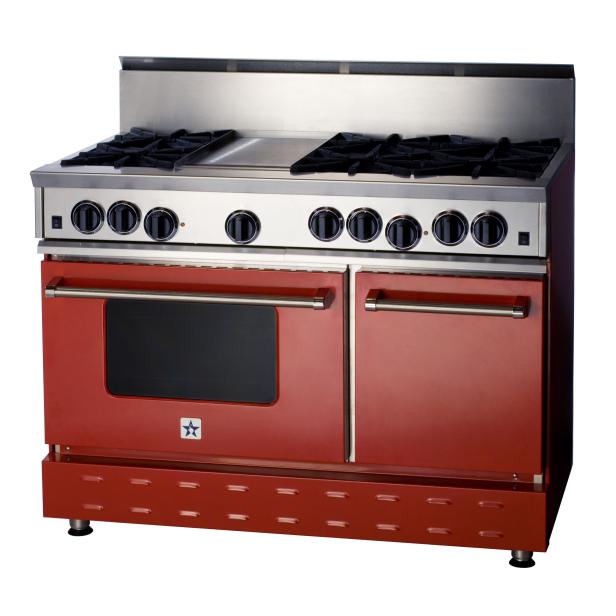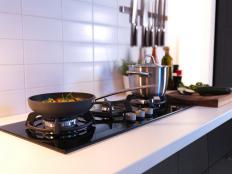Kitchen Range Buying Guide

Ranges combine a cooktop and oven into a single kitchen appliance. The alternative is to have a separate cooktop and single or double wall oven. All ranges are more than sufficient at boiling, baking, roasting and broiling. The primary distinguishing characteristic will be whether or not they do so with gas or electric. Other primary differences will include the types of burners, manual versus self-clean oven, convection baking, and any number of additional features.
Considerations When Choosing a Range
- What is your budget?
- Do you currently have gas or electric?
- What type of burner do you want?
Cost Range. Shoppers can expect to pay $350 for an entry-level electric coil range with manual clean oven and up to $2,000 or more for a stainless dual-fuel range with convection heating.
Size. The standard width of a residential range is 30 inches, but higher-end ranges can extend to 36 inches and beyond. The oven compartment on a typical range is 5 cubic feet, compared to just over 3 cubic feet in a typical wall oven.
Style. Ranges come in models sold as freestanding, slide-in and drop-in, says Jonathan Clinton, Kenmore product manager for Sears. The most common type is freestanding, called such because it can be placed anywhere in the kitchen given that it is finished on all sides. Slide-in and drop-in models, in contrast, have unfinished sides, making them useful only when surrounded by cabinetry. Drop-ins provide the most built-in look as the unit sits behind the cabinet baseboard.
Fuel Type. "What you have often determines what you buy," explains Clinton. Shoppers who have a gas line hook-up in their kitchen will likely purchase a gas-powered range, he says. Those who have electric are not likely to shell out the extra cash to run a gas line for a new appliance.
Dual-fuel: For those who do have a gas line hook-up, says Clinton, "dual-fuel provides the best of both worlds." This product category combines the power and speed of a gas cooktop with the precision and consistency of an electric oven.
Self- or Manual-Clean Oven. The first major decision after "gas or electric" is "manual or self-clean," Clinton says. "You have to ask yourself if it's worth the extra $300 for a few cleanings per year." For the majority of shoppers, the answer to that question is an easy "yes."
Burner Styles. The least expensive ranges are also the hardest to clean, Clinton says. These appliances feature electric coil burners that are notoriously difficult to clean. For approximately $150, buyers can step up to an easy-to-clean glass-top electric model. On the high end of the spectrum are state-of-the-art induction burners, which heat up fast, use less energy and are easy to clean thanks to a smooth ceramic top. The downside is that these appliances start at around $1,500.
Burner Quantity and Power. "As you step up in price, you step up in power and flexibility," Clinton says. A little extra cash will buy shoppers more powerful and more precise burner options. Expect to shell out $100 to $200 for a high-powered gas or electric burner. Stepping up to a mid-range model will provide a fifth burner, either an ultra-low warm-and-hold burner or a "bridge" burner that sits between two main burners, creating a large casserole-size heating surface.
Convection. Another major decision facing range buyers is whether or not to spend an additional $200 or so to get convection cooking, Clinton says. Convection uses an internal fan to circulate hot air throughout the oven compartment, which is said to improve heat distribution and reduce cook times. Higher-end models will have an additional heating element around the fan, sometimes called "true convection."
One Oven or Two. More and more ranges are ditching the oft-ignored storage drawer on the bottom of the range for an additional oven. Starting above $1,200, these ranges typically feature a slimmer upper oven perfect for pizzas, cookies and casseroles, and an almost full-size lower oven.
Ease-of-Use Features. While anything but mandatory, some up-sell features will make cooking somewhat less of a chore. "You have to decide what features are important to you," Clinton says. As ranges move up in price, they feature bigger and better viewing windows, brighter interior lighting, and temperature probes that alert the user when the roast is done. Pricier models will feature porcelain-coated racks in place of chrome ones that don't stand up to the heat of self-cleaning and thus must be removed. Full-extension racks on smooth-glide tracks also make cooking easier.
Controls and Settings. As the price tag goes up, controls go from simple knobs for a clock and timer up to fully digital technology that boasts preset cooking algorithms, Clinton says. Settings such as "delayed bake," which kicks on at a predetermined time, and "warm and hold," which does precisely that, are useful for the home cook who wants a hot meal waiting after a long day of work. A bread-proofing function maintains ultra-low temps perfect for rising dough. "Variable broil" provides a lower setting for a less intense top-down heating. Don't expect to find a full suite of these features in ranges priced less than $900.




































